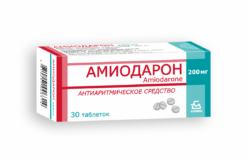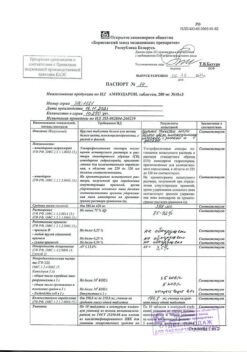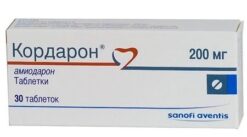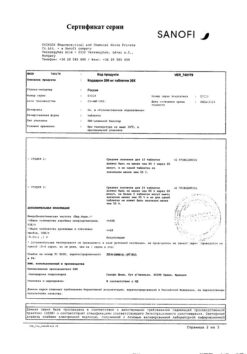No products in the cart.
Amiodarone, tablets 200 mg 30 pcs
€5.85 €5.12
Description
Antiarrhythmic drug
ATX code [C01BD01]
Pharmacological properties
Pharmacodynamics./b>
Pharmacodynamics
A class III antiarrhythmic drug (repolarization inhibitor). It also has antianginal, coronarodilator, alpha- and beta-adreno-blocker and antihypertensive action.
Blocks inactivated potassium (to a lesser extent calcium and sodium) channels of cell membranes of cardiomyocytes. By blocking inactivated “fast” sodium channels, it has effects typical for class I antiarrhythmic drugs. Inhibits slow (diastolic) depolarization of sinus node cell membrane, causing bradycardia, inhibits atrioventricular (AV) conduction (effect of class IV antiarrhythmics).
It has the properties of a non-competitive blocker of alpha- and beta-adrenoceptors.
The antiarrhythmic action of amiodarone is associated with its ability to cause increase of the duration of action potential of cardiomyocytes and effective refractory period of atria and ventricles of heart, AV node, Gis bundle, Purkinje fibers which is accompanied with decrease of sinus node automatism, slowdown of AV conduction, decrease of cardiomyocytes excitability.
The antianginal action is caused by decrease of myocardial oxygen demand due to slowing of heart rate (HR) and decrease of coronary artery resistance, which leads to increase of coronary blood flow. There is no significant effect on systemic arterial pressure (BP).
In its structure it is similar to thyroid hormones. The iodine content is about 37% of its molecular weight. It affects thyroid hormone metabolism, inhibits conversion of thyroxine (T4) into triiodothyronine (TZ) (blockade of thyroxine-5-deiodinase) and blocks capture of these hormones by cardiac cells and hepatocytes, which leads to weakening of stimulating effect of thyroid hormones on myocardium.
The onset of action (even when using “loading” doses) is from 2-3 days to 2-3 months, the duration of action varies from several weeks to months (determined in plasma for 9 months after stopping its use).
Pharmacokinetics
Intake
After oral administration it is slowly absorbed from the gastrointestinal tract, bioavailability is 35-65%. It is detected in the blood after 1/2-4 hours. Maximum concentration in blood after a single dose is observed after 2-10 hours. The range of therapeutic plasma concentration is 1-2.5 mg/l (but in determining the dose it is necessary to take into account the clinical picture). Time to reach steady-state concentration (TCss) – from one to several months (depending on individual characteristics).
Distribution
The volume of distribution is 60 liters, indicating intense distribution in the tissues. It has high fat solubility, in high concentrations is found in adipose tissue and organs with good blood supply (concentrations in adipose tissue, liver, kidney, myocardium are higher than in blood plasma by 300, 200, 50 and 34 times respectively).
Peculiarities of pharmacokinetics of amiodarone determine the necessity of using the drug in high loading doses. It penetrates through blood-brain barrier and placenta (10-50 %), is secreted with breast milk (25 % of dose received by mother). Binding with plasma proteins is 95% (62% – with albumin. 33.5% – with beta-lipoproteins).
Metabolism
Metabolized in the liver; the main metabolite is desethylamiodarone, which has similar pharmacological properties, can enhance the antiarrhythmic effect of the main compound. It may also be metabolized by deiodination (about 9 mg of elemental iodine is excreted at a dose of 300 mg). With prolonged treatment, iodine concentrations can reach 60-80% of amiodarone concentrations. It is a carrier of organic anions, an inhibitor of P-glycoprotein and CYP2C9, CYP2D6 and CYP3A4, CYP3A5, CYP3A7, CYP1AI, CYP1A2 isoenzymes. CYP2C19, CYP2A6, CYP2B6, CYP2C8 in the liver.
With regard to the ability to cumulate and the associated large variability in pharmacokinetic parameters, data on the elimination half-life (T1/2) are inconsistent. Amiodarone excretion after oral administration occurs in two phases: the initial period is 4-21 hours, in the second phase the T1/2 is 25-110 days (on average 20-100 days). After prolonged oral administration, the average T1/2 is 40 days (this is important in dose selection because at least 1 month may be needed to stabilize new plasma concentrations, while complete elimination may take more than 4 months).
It is excreted through the intestine – 85-95%, by the kidneys – less than 1% of the ingested dose (so there is no need to change the dosage if renal function is impaired). Amiodarone and its metabolites are not subject to dialysis.
Indications
Indications
Prevention of relapses of paroxysmal rhythm disturbances: life-threatening ventricular arrhythmias (including ventricular tachycardia and ventricular fibrillation); supraventricular arrhythmias (including with organic heart diseases, as well as with the ineffectiveness or impossibility of using other antiarrhythmic therapy); documented attacks of recurrent sustained supraventricular paroxysmal tachycardia in patients with Wolff-Parkinson-White syndrome; atrial fibrillation (atrial fibrillation) and atrial flutter.
Prevention of sudden death due to arrhythmia in patients at high risk: patients after a recent myocardial infarction with the number of ventricular extrasystoles more than 10/hour, with clinical signs of chronic heart failure (CHF) and left ventricular ejection fraction (LV) less than 40%.
Pharmacological effect
Pharmacological effect
Antiarrhythmic drug
ATX code [C01BD01]
Pharmacological properties
Pharmacodynamics
Class III antiarrhythmic drug (repolarization inhibitor). It also has antianginal, coronary dilation, alpha and beta adrenergic blocking and antihypertensive effects.
Blocks non-activated potassium (to a lesser extent, calcium and sodium) channels of the cell membranes of cardiomyocytes. By blocking inactivated “fast” sodium channels, it has effects characteristic of class I antiarrhythmic drugs. Inhibits the slow (diastolic) depolarization of the sinus node cell membrane, causing bradycardia, and inhibits atrioventricular (AV) conduction (the effect of class IV antiarrhythmics).
It has the properties of a non-competitive blocker of alpha and beta adrenergic receptors.
The antiarrhythmic effect of amiodarone is associated with its ability to cause an increase in the duration of the action potential of cardiomyocytes and the effective refractory period of the atria and ventricles of the heart, AV node, His bundle, Purkinje fibers, which is accompanied by a decrease in the automaticity of the sinus node, a slowdown in AV conduction, and a decrease in the excitability of cardiomyocytes.
The antianginal effect is due to a decrease in myocardial oxygen demand due to a decrease in heart rate (HR) and a decrease in coronary artery resistance, which leads to an increase in coronary blood flow. Does not have a significant effect on systemic blood pressure (BP).
Its structure is similar to thyroid hormones. The iodine content is about 37% of its molecular weight. It affects the exchange of thyroid hormones, suppresses the conversion of thyroxine (T4) to triiodothyronine (T3) (blockade of thyroxine-5-deiodinase) and blocks the uptake of these hormones by cardiocytes and hepatocytes, which leads to a weakening of the stimulating effect of thyroid hormones on the myocardium.
The onset of action (even when using “loading” doses) ranges from 2-3 days to 2-3 months, the duration of action varies from several weeks to months (determined in blood plasma for 9 months after stopping its use).
Pharmacokinetics
Suction
After oral administration, it is slowly absorbed from the gastrointestinal tract, bioavailability is 35-65%. Detected in the blood after 1/2-4 hours. The maximum concentration in the blood after taking a single dose is observed after 2-10 hours. The range of therapeutic plasma concentrations is 1-2.5 mg/l (but when determining the dose, it is necessary to keep in mind the clinical picture). The time to reach steady-state concentration (TCss) is from one to several months (depending on individual characteristics).
Distribution
The volume of distribution is 60 l, which indicates intensive distribution in tissues. It has high fat solubility and is found in high concentrations in adipose tissue and organs with good blood supply (the concentration in adipose tissue, liver, kidneys, myocardium is higher than in blood plasma by 300, 200, 50 and 34 times, respectively).
The pharmacokinetics of amiodarone necessitate the use of the drug in high loading doses. Penetrates the blood-brain barrier and the placenta (10-50%), secreted into breast milk (25% of the dose received by the mother). Connection with blood plasma proteins is 95% (62% with albumin. 33.5% with beta-lipoproteins).
Metabolism
Metabolized in the liver; the main metabolite is desethylamiodarone, which has similar pharmacological properties and may enhance the antiarrhythmic effect of the main compound. Possibly also metabolized by deiodination (at a dose of 300 mg, approximately 9 mg of elemental iodine is released). With prolonged treatment, iodine concentrations can reach 60-80% of amiodarone concentrations. It is a carrier of organic anions, an inhibitor of P-glycoprotein and isoenzymes CYP2C9, CYP2D6 and CYP3A4, CYP3A5, CYP3A7, CYP1AI, CYP1A2. CYP2C19, CYP2A6, CYP2B6, CYP2C8 in the liver.
Removal
Given the ability to cumulate and the associated large variability of pharmacokinetic parameters, data on the half-life (T1/2) are contradictory. The elimination of amiodarone after oral administration is carried out in 2 phases: the initial period is 4-21 hours, in the second phase T1/2 – 25-110 days (on average 20-100 days). After prolonged oral administration, the average T1/2 is 40 days (this is important when choosing a dose, since at least 1 month may be needed to stabilize the new plasma concentration, while complete elimination may last more than 4 months).
Excreted through the intestines – 85-95%, by the kidneys – less than 1% of the dose taken orally (therefore, if renal function is impaired, there is no need to change the dosage). Amiodarone and its metabolites are not dialyzable.
Special instructions
Special instructions
Caution should be exercised when prescribing the drug to patients with heart failure, liver disease, hypokalemia, porphyria, and elderly patients.
Before starting treatment and every 6 months during therapy, it is recommended to check the function of the thyroid gland, the activity of “liver” transaminases and conduct an X-ray examination of the lungs and consultation with an ophthalmologist. Monitoring ECGs must be taken every 3 months.
It should be taken into account that the use of Amiodarone may distort the results of determining the concentration of thyroid hormones (triiodothyronine, thyroxine, thyroid-stimulating hormone).
If the heart rate is below 55 beats/min, the drug must be temporarily discontinued.
When using the drug Amiodarone, changes in the ECG are possible: prolongation of the QT interval with the possible appearance of a U wave. If atrioventricular block of the second and third degrees, sinoatrial block, and bundle branch block occurs, treatment with Amiodarone should be stopped immediately.
If discontinued, relapses of cardiac arrhythmias are possible. After discontinuation of the drug, the pharmacodynamic effect persists for 10-30 days. Before performing surgical interventions, as well as oxygen therapy, it is necessary to warn the doctor about the use of the drug Amiodarone, since there have been rare cases of the development of acute respiratory distress syndrome in adult patients in the postoperative period.
To avoid the development of photosensitivity, patients should avoid exposure to the sun. Lipofuscin deposition in the corneal epithelium decreases independently when the dose is reduced or Amiodarone is discontinued. Skin pigmentation decreases after stopping use of the drug and gradually (over 1-4 years) completely disappears. After cessation of treatment, as a rule, spontaneous normalization of thyroid function is observed.
Information about the possible impact on the ability to drive vehicles and machinery
During the treatment period, you should refrain from driving a vehicle and engaging in potentially hazardous activities that require increased concentration and speed of psychomotor reactions.
Active ingredient
Active ingredient
Amiodarone
Composition
Composition
Composition per tablet:
Active substance:
Amiodarone hydrochloride – 200.0 mg,
Excipients:
Lactose monohydrate – 100.0 mg,
potato starch – 60.6 mg,
microcrystalline cellulose – 24.0 mg,
talc – 7.0 mg, povidone (polyvinylpyrrolidone) – 4.8 mg,
calcium stearate – 3.6 mg.
Pregnancy
Pregnancy
Amiodarone should not be used during pregnancy, since during this period the thyroid gland of the newborn begins to accumulate iodine, and the use of Amiodarone during this period can provoke the development of hypothyroidism due to an increase in iodine concentration. Use during pregnancy and lactation is possible only in case of life-threatening rhythm disturbances when other antiarrhythmic therapy is ineffective, since the drug causes dysfunction of the fetal thyroid gland.
Amiodarone crosses the placenta (10-50%) and is secreted into breast milk (25% of the dose received by the mother), so the drug is contraindicated for use during lactation. If use is necessary during lactation, breastfeeding should be discontinued.
Contraindications
Contraindications
Hypersensitivity to any of the components of the drug or iodine; sick sinus syndrome (sinus bradycardia and sinoatrial block in the absence of a pacemaker (risk of sinus node arrest); atrioventricular block TI-III degree, two- and three-fascicle blocks (in the absence of a pacemaker); hypothyroidism, hyperthyroidism; severe arterial hypotension; lactose intolerance, lactase deficiency, glucose-galactose syndrome malabsorption; hypokalemia, hypomagnesemia; pregnancy, breastfeeding; concomitant use of monoamine oxidase inhibitors, drugs that prolong the QT interval, congenital or acquired prolongation of the QT interval;
With caution
Chronic heart failure (CHF) (III-IV functional class according to the New York Heart Association classification of chronic heart failure – NYHA), first degree atrioventricular block, liver failure, bronchial asthma, old age (high risk of developing severe bradycardia).
If you have one of the listed diseases, be sure to consult your doctor before using the drug.
Side Effects
Side Effects
Frequency: very common (10% or more), common (1% or more; less than 10%), uncommon (0.1% or more; less than 1%), rare (0.01% or more; less than 0.1%), very rare (less than 0.01%, including isolated cases), frequency unknown (it is not possible to determine the frequency based on available data).
From the cardiovascular system: often – moderate bradycardia (dose-dependent); infrequently – sinoatrial and atrioventricular blockade of various degrees, proarrhythmogenic effect; very rarely – severe bradycardia, sinus node arrest (in patients with sinus node dysfunction and elderly patients); frequency unknown – ventricular tachycardia of the “pirouette” type, progression of symptoms of chronic heart failure (with long-term use).
From the digestive system: very often – nausea, vomiting, loss of appetite, dullness or loss of taste, metallic taste in the mouth, feeling of heaviness in the epigastrium, isolated increase in the activity of “liver” transaminases; often – acute toxic hepatitis with increased activity of “liver” transaminases and/or jaundice, including the development of liver failure; very rarely – chronic liver failure.
From the respiratory system: often – interstitial or alveolar pneumonitis, bronchiolitis obliterans with pneumonia, pleurisy, pulmonary fibrosis; very rarely – bronchospasm in patients with severe respiratory failure (especially in patients with bronchial asthma), acute respiratory syndrome; frequency unknown – pulmonary hemorrhage.
On the part of the organ of vision: very often – microdeposits in the corneal epithelium, consisting of complex lipids, including lipofuscin (complaints about the appearance of a colored halo or blurred outlines of objects in bright lighting); very rarely – optic neuritis/optic neuropathy.
Metabolism: often – hypothyroidism, hyperthyroidism; very rarely – syndrome of impaired secretion of antidiuretic hormone. From the skin
integument: very often – photosensitivity; often – grayish or bluish pigmentation of the skin (with long-term use), disappears after stopping the drug; very rarely – erythema (with simultaneous radiation therapy), skin rash, exfoliative dermatitis (no connection with the drug has been established), alopecia; frequency unknown – urticaria.
From the nervous system: often – tremor and other extrapyramidal disorders, sleep disturbance; uncommon – peripheral neuropathy and/or myopathy; very rarely – cerebellar ataxia, benign intracranial hypertension, headache.
Other: frequency unknown – angioedema, formation of granulomas, including bone marrow granulomas; very rarely – vasculitis, epididymitis, impotence (no connection with the drug has been established), thrombocytopenia, hemolytic and aplastic anemia.
If any adverse reactions occur, you should stop using the drug and consult a doctor.
If any of the side effects listed in the instructions get worse or you notice any other side effects not listed in the instructions, tell your doctor.
Interaction
Interaction
Contraindicated combinations: risk of developing polymorphic ventricular tachycardia of the “pirouette” type (arrhythmia characterized by polymorphic complexes that change the amplitude and direction of excitation in the ventricles relative to the isoline (electrical systole of the heart): class IA antiarrhythmic drugs (quinidine, hydroquinidine, disopyramide, procainamide), class III (dofetilide, ibutilide, bretylium tosylate), sotalol; bepridil, vincamine, phenothiazines (chlorpromazine, cyamemazine, levomepromazine, thioridazine, trifluoperasia, fluphenasia), benzamides (amisulpride, sultopride, sulpiride, tiapride, veraliprid), butyrophenones (droperidol, haloperidol), sertindole, pimozide; tricyclic antidepressants, cisapride, macrolides (erythromycin IV, spiramycin), azoles, antimalarial drugs (quinine, chloroquine, mefloquine, halofantrine, lumefantrine (parenteral), difemanil methyl sulfate, mizolastine, astemizole, terfenadine, fluoroquinolones (in); including moxifloxacin).
Not recommended combinations: beta-blockers, blockers of “slow” calcium channels (verapamil, diltiazem) – risk of impaired automaticity (severe bradycardia) and conduction; laxatives that stimulate intestinal motility – the risk of developing ventricular tachycardia of the “pirouette” type against the background of hypokalemia caused by laxatives.
Combinations that require use with caution: diuretics that cause hypokalemia, amphotericin B (intravenously), systemic glucocorticosteroids, tetracosactide – the risk of developing ventricular arrhythmias, incl. ventricular tachycardia of the “pirouette” type; procainamide – risk of developing side effects of procainamide (amiodarone increases the plasma concentration of procainamide and its metabolite -N-acetylprocainamide).
Indirect anticoagulants (warfarin) – amiodarone increases the concentration of warfarin (risk of bleeding) due to inhibition of the CYP2C9 isoenzyme; cardiac glycosides – disturbance of automaticity (severe bradycardia) and AV conduction (increased concentration of digoxin).
Esmolol – a violation of contractility, automaticity and conductivity (suppression of compensatory reactions of the sympathetic nervous system). Phenytoin, fosphenytoin – risk of developing neurological disorders (amiodarone increases the concentration of phenytoin due to inhibition of the CYP2C9 isoenzyme).
Flecainide – amiodarone increases its concentration (due to inhibition of the CYP2D6 isoenzyme).
Medicines metabolized with the participation of the CYP3A4 isoenzyme (cyclosporine, fentanyl, lidocaine, tacrolimus, sildenafil, midazolam, triazolam, dihydroergotamine, ergotamine, HMG-CoA reductase inhibitors) – amiodarone increases their concentration (the risk of developing their toxicity and/or enhancing pharmacodynamic effects when taken together amiodarone with high doses of simvastatin increases the likelihood of developing myopathy).
Orlistat reduces the concentration of amiodarone and its active metabolite; clonidine, guanfacine, cholinesterase inhibitors (donepezil, galantamine, rivastigmine, tacrine, ambenonium chloride, pyridostigmine, neostigmine), pilocarpine – risk of developing severe bradycardia.
Cimetidine and grapefruit juice slow down the metabolism of amiodarone and increase its plasma concentration.
Inhalation drugs for general anesthesia – the risk of developing bradycardia (resistant to atropine administration), acute respiratory distress syndrome, incl. fatal, the development of which is associated with high oxygen concentrations, the risk of decreased blood pressure, cardiac output, and conduction disturbances.
Radioactive iodine – amiodarone (contains iodine) can interfere with the absorption of radioactive iodine, which can distort the results of radioisotope studies of the thyroid gland.
Rifampicin and St. John’s wort preparations (strong inducers of the CYP3A4 isoenzyme) reduce the concentration of amiodarone in the blood plasma.
HIV protease inhibitors (CYP3A4 isoenzyme inhibitors) may increase plasma concentrations of amiodarone.
Drugs that cause photosensitivity have an additive photosensitizing effect.
Clopidogrel – a decrease in its plasma concentration is possible; dextromethorphan (substrate of the CYP3A4 and CYP2D6 isoenzymes) – its concentration may increase (amiodarone inhibits the CYP2D6 isoenzyme). Dabigatran – an increase in its concentration in the blood plasma when used simultaneously with amiodarone.
Overdose
Overdose
Symptoms: bradycardia, AV block, ventricular tachycardia of the “pirouette” type, paroxysmal tachycardia of the “pirouette” type, worsening of symptoms of existing CHF, impaired liver function, cardiac arrest.
Treatment: gastric lavage, intake of activated charcoal, symptomatic therapy (for bradycardia – beta-adrenergic stimulants, atropine or installation of a pacemaker; for tachycardia of the “pirouette” type – intravenous administration of magnesium salts, cardiac stimulation). Hemodialysis is ineffective.
Storage conditions
Storage conditions
In a place protected from light at a temperature not exceeding 25 °C.
Keep out of the reach of children.
Shelf life
Shelf life
2 years.
Do not use after the expiration date stated on the package.
Manufacturer
Manufacturer
Ozon, Russia
Additional information
| Shelf life | 2 years. Do not use after the expiration date stated on the package. |
|---|---|
| Conditions of storage | In the dark place at a temperature not exceeding 25 ° C. Keep out of reach of children. |
| Manufacturer | Ozon, Russia |
| Medication form | pills |
| Brand | Ozon |
Other forms…
Related products
Buy Amiodarone, tablets 200 mg 30 pcs with delivery to USA, UK, Europe and over 120 other countries.



















